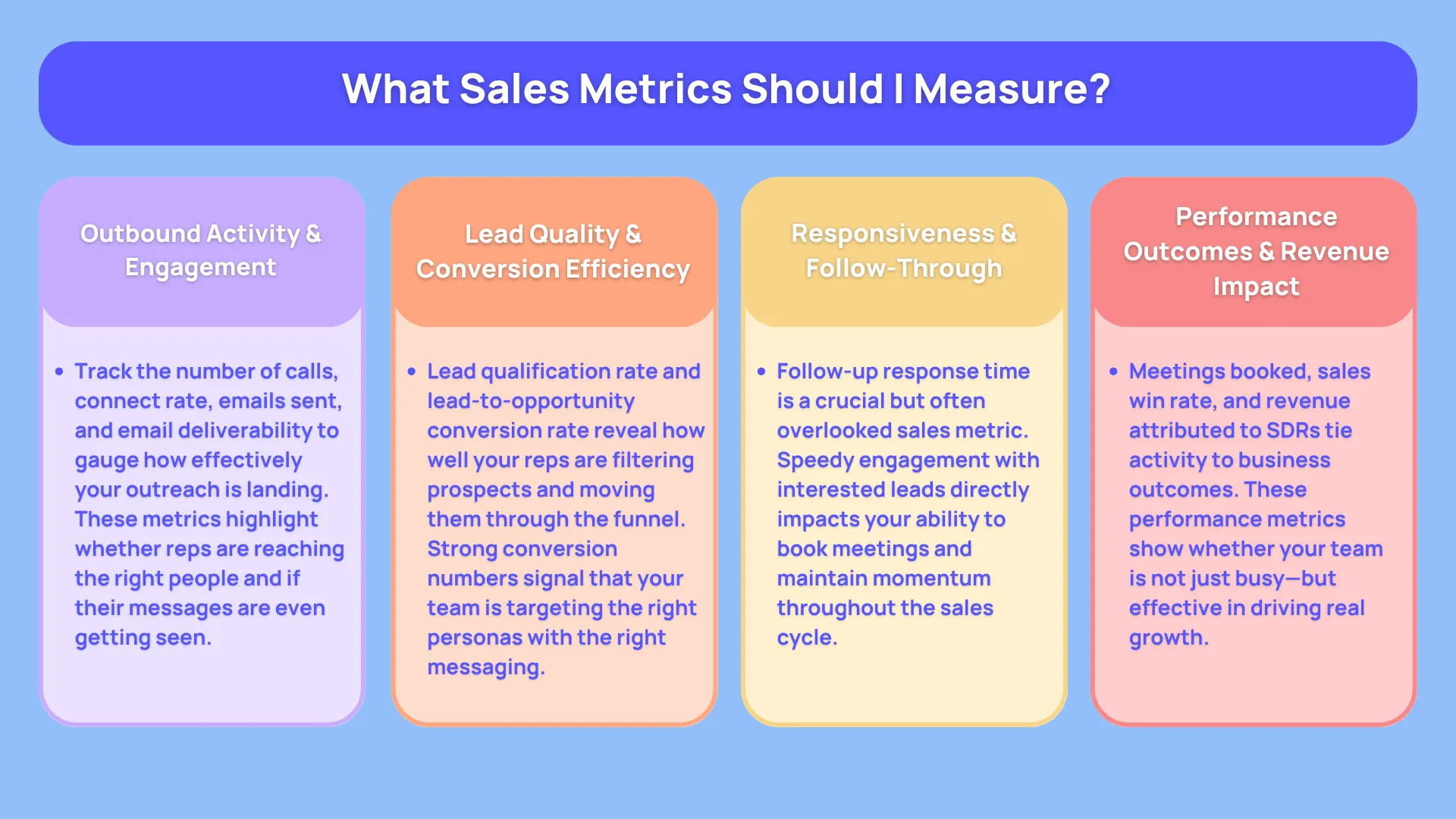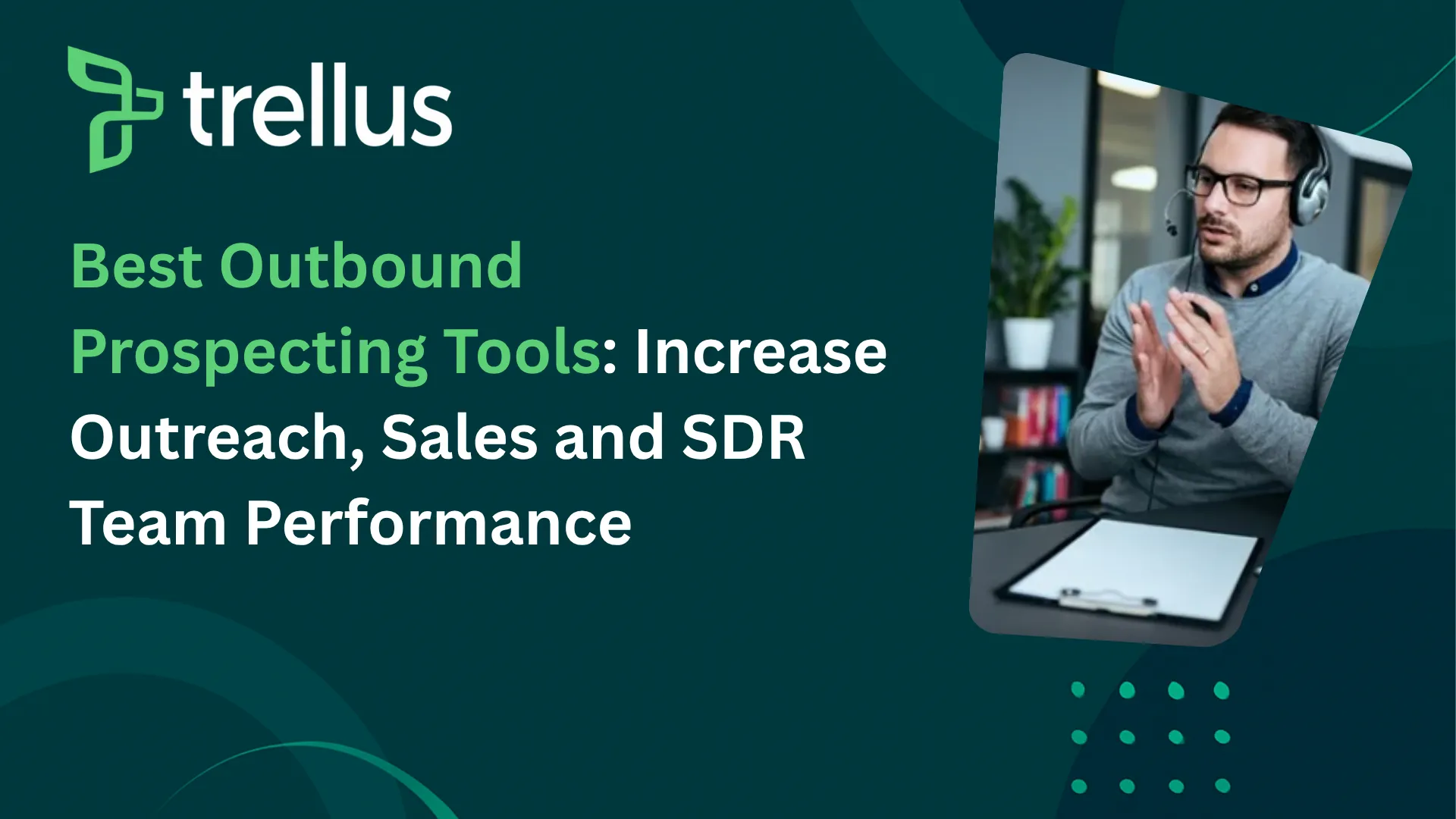
Our Top Picks


What really defines the success of a sales development rep or an account executive?
Is it the sheer volume of cold calls made each day?
Maybe it’s the email reply rate or how many meetings are set up for the sales team?
Or could it be something more directly tied to the bottom line, like revenue sourced or influenced?
The truth is, no single answer applies to every team.
The same logic applies to businesses set up on different scales. It’s possible that you and your competitor are working in the same industry, attending to the same type of audience, and selling more or less the same products through cold calls, but metrics could tell a different story.
Sales metrics are more of a quantifiable factor that aren’t set in stone. It is all the more reason to have experts in your team who know their stuff and understand different buyer personas, marketing strategies, adaptability to customer pain points, etc.
So, from that point of view, sales productivity metrics something, we’d say, based on part experience and part knowledge/ skills. And that’s exactly where a lot of companies fall short.
That also translates to setting smarter goals. It also means spotting inefficiencies before they become bottlenecks. Whether you’re managing inbound or outbound SDRs or tracking seasoned AEs, the right sales productivity metrics can make or break your sales performance management strategy.
Let’s walk through the key sales metrics that actually matter—and how to measure sales performance in a way that fuels growth, not just activity.
Understanding the Role of SDRs and AEs in the Sales Process
Before jumping into performance tracking, it’s important to understand how SDRs and AEs contribute to the bigger picture.
Sales Development Representatives (SDRs) work at the top of the sales funnel.
Their primary role is to initiate contact with leads, qualify interest, and hand off good-fit prospects to account executives.
Account Executives (AEs), on the other hand, are responsible for taking those qualified leads, managing the relationship, and closing deals. Where SDRs are the spark, AEs are the engine that drives revenue home.
Because their responsibilities differ, their performance must be measured through separate lenses. The key is to align expectations, processes, and targets with the right sales measurement metrics.
What Is a Sales Metric?

A sales metric is a quantifiable measure used to assess specific aspects of sales performance. It’s not just about tracking activities—it’s about making sense of outcomes.
From how many leads an SDR qualifies to how many deals an AE closes, sales metrics give visibility into what’s working and what needs attention. These metrics can be broken down into two main categories: activity metrics and performance metrics.
- Activity metrics look at effort—calls made, emails sent, follow-ups completed.
- Performance metrics focus on outcomes—appointments set, opportunities created, deals closed, and revenue generated.
Together, they create a full picture of your team’s effectiveness.
From a broad spectrum point of view, the sales metric rabbit hole goes a lot deeper. Depending on the business requirements, outside variants that affect the business’s susceptibility to approaching prospects and such things, there are a couple of things that you need to know.
Read on…
Why Sales Productivity Metrics Matter
Sales productivity metrics aren’t just for weekly reviews or sales huddles.
They’re essential tools for identifying bottlenecks, setting realistic quotas, and understanding the true value your team brings to the organization.
Teams that consistently track and optimize their key metrics for sales performance tend to hit higher revenue goals and operate with less waste. You don’t just see more calls—you see more results from those calls.
Inbound vs. Outbound SDRs: Different Roles, Different Metrics
Not all SDRs are the same—and their metrics shouldn’t be either.
Why so?
It’s because of different factors such as stakeholder requirements, internal audits related to conversions during the last so and so period, the type of audience you’re mostly used to engaging with - so on and so forth.
So, as we said earlier in this post, sales productivity metrics are supposed to be something personalized to your business operations, marketing campaigns, and seasonal changes over time.
Other than that, here’s what you should be doing internally from a productivity point of view:
Inbound SDRs handle leads that are generated from marketing efforts—think content downloads, demo requests, or webinar attendees. Their sales performance metrics examples often revolve around response time and conversion to a meeting.
Outbound SDRs work harder to generate their own leads through prospecting. That means more emphasis on dials, email outreach, and lead qualification. Here, the key metrics for sales performance are volume-driven but still tied to quality.
Understanding this split helps managers know what sales metrics they should measure to track team health and individual contribution more accurately.
What Sales Metrics Should I Measure? The Non-Negotiables For Sales Managers To Know These Days

Now comes the big question: how do you measure sales performance in a meaningful way?
Let’s double down on the core sales performance metrics that every SDR and AE team should be tracking—along with why they matter.
1. Number of Calls (Dials) and Connect Rate
What It Tells You: This is the most basic measure of activity for any outbound SDR team. It tracks how many calls are made and how many actually connect with prospects.
Why It Matters: Volume without connection means wasted effort. A low connect rate often signals poor lead data, bad timing, or outdated outreach methods. On the flip side, a high connect rate opens the door to more qualified meetings.
Pro Tip: Look beyond total dials. Track connect rate and decision-maker contact rate to get a clearer picture of quality engagement.
2. Emails Sent and Email Deliverability
What It Tells You: Email volume reflects how much outbound communication is happening. Deliverability metrics show whether your emails are reaching inboxes.
Why It Matters: Sending emails is easy. Getting them seen is not. Deliverability issues could point to domain problems, poor data hygiene, or spam-triggering templates.
Improvement Levers: Better targeting, validated email lists, domain warm-up practices, and solid subject lines can lift this metric meaningfully.
3. Email Response Rate
What It Tells You: This measures how many of those sent emails actually get a reply. It’s a simple yet powerful signal of how relevant and compelling your messaging is.
Why It Matters: A low response rate suggests misaligned messaging or weak ICP targeting. Improving this metric means higher odds of starting meaningful conversations.
Tactics That Work: Personalization, timing based on buyer persona behavior, strong calls-to-action, and testing different copy angles can dramatically boost your replies.
4. Meetings Booked
What It Tells You: This metric tracks how many meetings an SDR is successfully setting up with qualified leads.
Why It Matters: Meetings are often the main objective for SDRs. They act as a handoff point to AEs and signal how effectively an SDR is converting engagement into pipeline.
Benchmarks to Know: Most SDRs average between 10 and 20 qualified meetings per month. AI tools can often help scale this number by automating outreach and scheduling tasks.
5. Lead Qualification Rate
What It Tells You: This shows how many cold or inbound leads become sales-qualified leads (SQLs). It reflects both the quality of outreach and how well reps identify fit.
Why It Matters: A high volume of outreach means nothing if you’re qualifying the wrong leads. Sales measurement metrics like this are essential for filtering noise from real opportunity.
Qualifying Frameworks: BANT (Budget, Authority, Need, Timeline) remains a staple, though other models like MEDDIC or CHAMP can also be effective depending on your process.
6. Lead-to-Opportunity Conversion Rate
What It Tells You: This metric reflects the percentage of leads that move from being qualified to entering your sales pipeline as real opportunities.
Why It Matters: It bridges the gap between SDR activity and AE outcomes. A strong conversion rate means your SDRs are feeding the pipeline with high-quality prospects.
Where to Look: Poor conversion often stems from either unfit leads being passed to AEs or lack of nurturing in the early stages. Clear qualification standards help reduce drop-off.
7. Follow-Up Response Time
What It Tells You: This tracks how quickly SDRs are replying to leads once they express interest or request more information.
Why It Matters: Speed is everything. Leads are most engaged within the first five minutes. Waiting even an hour can drastically reduce the chance of booking a meeting.
Reality Check: The average SDR response time is over 40 hours—an unacceptable gap in most competitive spaces. This metric helps sales leaders correct that quickly.
8. Sales Win Rate
What It Tells You: This metric measures how many deals were won out of all that were pursued. It’s a key performance indicator for AEs and full-cycle reps.
Why It Matters: A solid win rate shows that your sales team knows how to close. It’s not just about getting prospects to the table—it’s about turning them into customers.
How to Improve It: Segment win rate by industry, persona, product line, or sales rep to uncover patterns. Then optimize training, positioning, or objection handling based on what’s working.
9. Revenue Attributed to SDRs
What It Tells You: Revenue influenced or sourced by SDRs is a long-term measure of impact. It links early-funnel work to final outcomes.
Why It Matters: Too often, SDRs are only evaluated on volume. But their real value lies in the revenue their leads eventually generate. Tracking this metric shows whether their time is being spent on the right accounts.
Calculation Tip: Tie each closed deal back to the SDR who first engaged the lead. Many CRMs allow you to tag records and view performance attribution automatically.
How Do You Measure Sales Performance the Right Way?
Knowing the metrics is one thing. Measuring them correctly is another.
Here are three simple ways to build a sustainable measurement process that supports high performance across your team.
Use Your CRM as the Source of Truth
CRMs like Salesforce and HubSpot aren’t just for tracking leads.
They’re your central dashboard for managing all sales performance management metrics. Connect your CRM with outreach tools, phone systems, and email automation to get a 360-degree view of rep activities and outcomes.
Set Goals That Make Sense
Every sales org has quotas, but not every quota makes sense.
Ground your targets in historical performance data and industry benchmarks. Use SMART goal-setting to avoid sandbagging or setting the bar impossibly high.
Sales metrics templates can help align reps, managers, and leadership on what good performance looks like.
Make Time for Regular Reviews
Data doesn’t do much unless you’re acting on it. Schedule biweekly or monthly reviews to go over your sales productivity metrics and identify areas of improvement.
Pair these reviews with individual coaching sessions so reps feel supported, not just monitored.
What Sales Metrics Should I Measure?
There’s no universal playbook for tracking performance in sales.
But ignoring the data is never an option. Whether you’re coaching SDRs to sharpen outreach or supporting AEs through long deal cycles, success comes down to understanding what drives results—and doubling down on it.
If you're still asking "what is a sales metric?" or wondering how to measure sales performance effectively, start with what matters most to your sales motion: engagement, qualification, conversion, and revenue.
From there, you’ll find that each metric adds a layer to the story—one that helps you build a smarter, stronger sales team that knows how to win.
Frequently Asked Questions

How do you measure sales performance without relying too heavily on activity metrics?
Activity metrics like calls made or emails sent can be helpful indicators of effort, but they don’t always reflect actual performance.
To truly understand how a rep is performing, you need to look at outcome-based metrics such as lead-to-opportunity conversion rate, meetings booked, or revenue influenced.
These reveal whether their efforts are translating into pipeline growth or closed deals.
A balanced approach means blending quantity and quality. You can track how often reps are reaching out, but also how well those efforts are converting. Measuring follow-up speed, email response rates, and deal progression gives a far more complete picture than raw volume alone.
What sales metrics should I measure to understand the health of my pipeline?
It really depends on your sales structure and where your team fits in the funnel. If you manage SDRs, you’ll want to focus on how effectively leads are being qualified and whether meetings are being booked with the right personas. Look closely at lead qualification rate and lead-to-opportunity conversion.
For AEs, pipeline health revolves more around win rate, average deal size, and sales cycle length. These show how efficiently deals move through the funnel and whether your reps are focusing on opportunities that can realistically close. A steady mix of early, mid, and late-stage deals also signals a healthy pipeline worth watching over time.
What is a good win rate and how should it be evaluated?
There’s no magic number that fits every business.
We’d say that a strong win rate in a transactional sales environment might be 30–40%, while in enterprise sales, even 20% could be excellent. What matters most is how your win rate compares to your historical performance and industry benchmarks.
It’s also useful to segment your win rate across different dimensions.
Feel free to further break it down by industry vertical, product type, deal size, or even rep.
Doing so will help you identify where your sales team thrives and where extra support or training may be needed. Win rate isn’t just about closing deals—it’s a directional signal for your entire sales strategy.
Why do sales productivity metrics matter beyond just individual rep performance?
Sales metrics aren’t only about grading reps—they’re tools for understanding systemic efficiency. If reps are consistently failing to convert qualified leads into opportunities, the issue might be with your messaging, your ICP definition, or even your product-market fit. Metrics help you identify these patterns before they become costly problems.
They’re also critical for forecasting and resource planning. If you were to understand conversion rates, sales velocity, and average deal value, leaders can build more reliable projections and allocate resources where they’re needed most.
At the end of the day, productivity metrics shape everything from daily coaching to long-term growth strategy.







